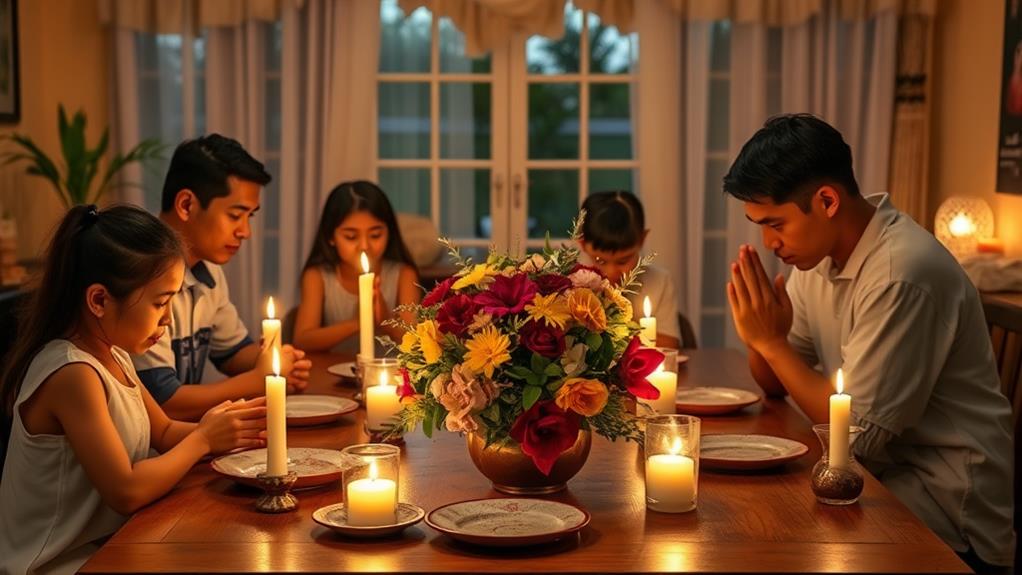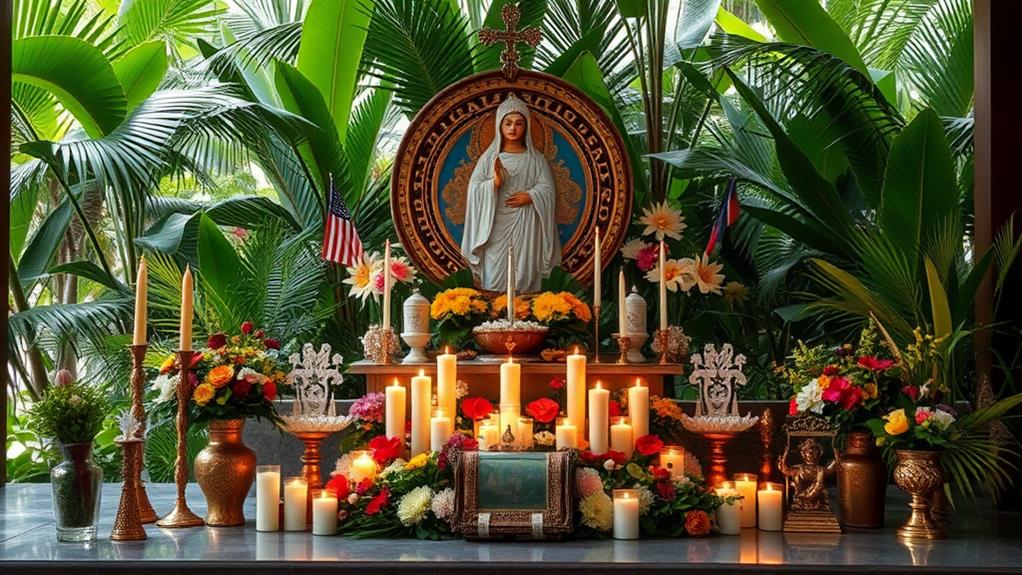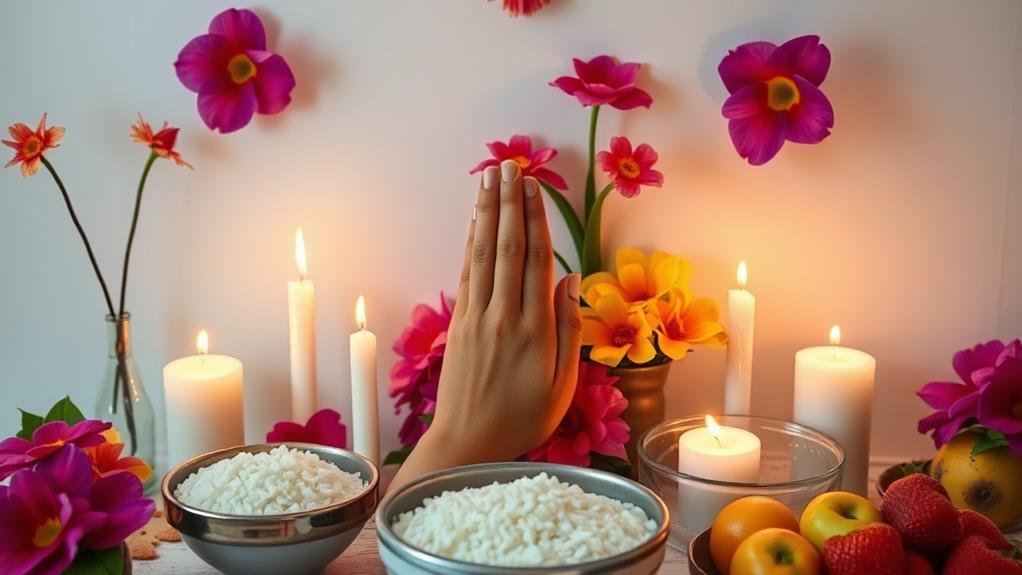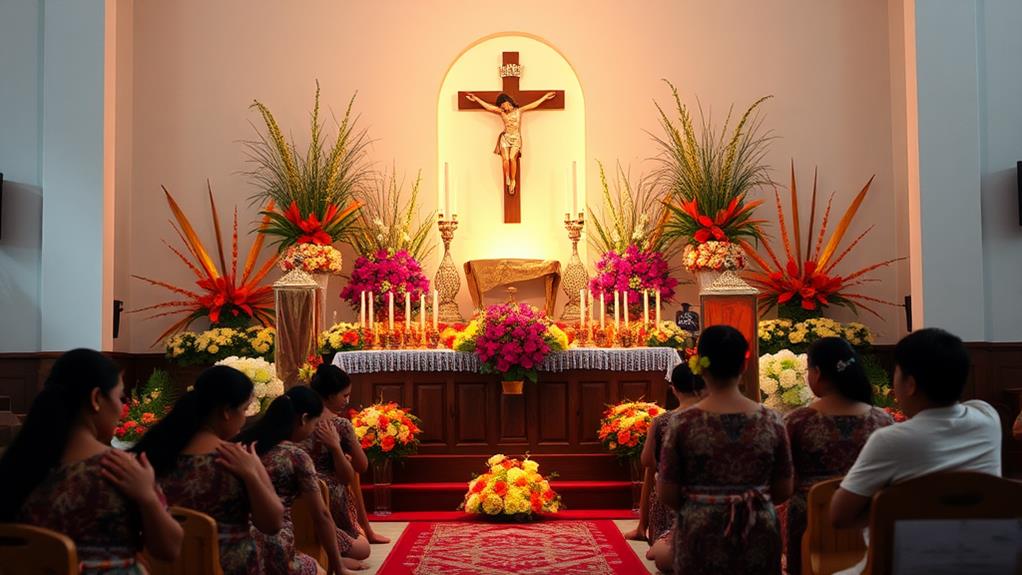Prayer is a cornerstone of Filipino culture, fostering unity and resilience in the face of adversity.
Daily prayer rituals bring comfort and solace to individuals and families during times of illness, emotional strife, and calamities.
Communal prayer gatherings, particularly during traditional events like Simbang Gabi, showcase the collective spirit of the Filipino people, where gratitude and spirituality intertwine.
Elders play a vital role in guiding the younger generation, ensuring the preservation of these cherished practices.
Each prayer moment resonates with a profound sense of belonging, reflecting the heart of Filipino identity.
Significance of Prayer

Prayer is a vital component of Filipino culture, deeply ingrained in daily life. It's a frequent practice that underscores its significance, binding families together during both joyful and sorrowful occasions. For instance, during Simbang Gabi, a series of early morning masses leading up to Christmas, families gather to express gratitude and deepen their spiritual connection, demonstrating the power of prayer in uniting communities.
In times of emotional distress or illness, prayer serves as a source of strength and comfort. Filipinos often turn to clergy for support, seeking solace through shared prayers. This collective act provides guidance and comfort, as seen in the way prayer plays a vital role during national calamities, offering a means for communities to cope together and seek divine intervention.
Prayer is also an integral part of cultural events, illustrating its significance in daily life. The importance of prayer reflects a profound belief in its power, shaping not just individual lives but also the collective identity of the Filipino people.
It is a reminder that, in every moment, whether joyous or sorrowful, prayer remains a powerful force in navigating life's complexities.
Cultural Expressions of Faith
Filipino culture is deeply rooted in expressions of faith, which play a significant role in daily life and special occasions.
In the Philippines, spiritual practices are an integral part of daily routines. For instance, Simbang Gabi, a series of early morning masses, celebrates Christmas and strengthens faith.
Similarly, weddings and funerals are significant life events that involve prayerful ceremonies, uniting families and honoring the deceased.
Collective prayer events, such as the National Day of Prayer, bring people together, reinforcing shared values and moral frameworks. These events foster unity in times of crisis and demonstrate the importance of faith in Filipino culture.
Family gatherings are also an essential aspect of Filipino culture, where collective prayer at home strengthens bonds and promotes support.
These gatherings reinforce the deep connections among families and communities, providing comfort and hope.
In Filipino culture, expressions of faith aren't just individual devotions but also a collective display of resilience.
Prayer isn't just a ritual; it is a source of hope and comfort that reinforces the strong bonds within families and communities.
Prayer in Daily Life

Prayer as a Comforting Ritual
In many daily lives, prayer serves as a comforting ritual that creates a sense of peace and connection.
Families gather each morning or evening, hands clasped, to share hopes and concerns in heartfelt prayer, strengthening bonds between family and friends and fostering a shared sense of purpose and devotion.
Prayer in Significant Moments
During significant moments, prayer becomes a celebration of faith that enriches the community's cultural fabric.
In the tradition of Simbang Gabi, streets bustle with early risers heading to dawn masses, their spirits lifted by the collective energy of prayer. This collective prayer is more than just a religious obligation; it brings people together and reinforces community bonds.
Prayer as a Coping Mechanism
In challenging times, such as health crises, prayer becomes a powerful coping mechanism. Families turn to their faith to alleviate fears, seeking divine guidance and comfort.
The presence of religious icons in homes acts as a constant reminder of this commitment to daily prayer, reinforcing values that prioritize love, hope, and resilience. Through these shared moments, prayer creates a tapestry of connection that envelops both family and friends in unwavering support.
Community Gatherings and Prayer
Community gatherings centered around prayer strengthen family bonds and foster a sense of unity. In Filipino culture, collective prayer brings people together, creating a shared space where values and beliefs are reinforced. For instance, during Simbang Gabi, a traditional Christmas celebration, families and friends gather to pray and sing together, their faces illuminated by candlelight, as they strengthen their ties to one another.
In times of crisis, community prayer gatherings take on a profound significance. When natural disasters or national calamities occur, entire communities come together to seek divine intercession, fostering empathy and compassion. This collective act of prayer extends beyond immediate families, uniting neighbors and friends in a shared moment of hope and support.
Cultural celebrations also incorporate prayer, nurturing spiritual growth and community ties. During fiestas and barangay gatherings, prayer is an integral part of the celebration, reminding participants that they're connected through a shared heartbeat of faith.
Each moment spent in prayer reinforces the sense of community and solidarity that defines the Filipino spirit.
Spiritual Resilience During Challenges

Prayer serves as a vital source of strength for individuals facing challenges, particularly Filipina Americans battling breast cancer. This sacred ritual offers emotional and spiritual support, helping to alleviate physical pain and soothe deep-seated fears. When individuals pray, they often close their eyes, whisper heartfelt words, and seek strength from a higher power, believing that each prayer brings them closer to recovery.
Prayer transforms illness into a test of faith, cultivating profound resilience within individuals. Families and communities come together, engaging in communal prayers that foster a sense of belonging and hope. This collective act of devotion reinforces the belief that miracles can happen through faith.
The cultural emphasis on prayer as a means of healing instills a powerful resilience in those facing daunting health challenges.
In the midst of uncertainty, prayer becomes a beacon of light, reminding individuals that support and comfort are always within reach.
Intergenerational Prayer Practices
Intergenerational Prayer Practices Strengthen Family Bonds
In many Filipino families, intergenerational prayer practices serve as a source of strength and unity.
The presence of elders enriches the experience, as they lead the group in praying the Rosary, passing down a legacy of faith that binds generations. Younger members listen intently, absorbing lessons about spirituality and community.
Collective Prayers Mark Significant Life Events
During significant life events like baptisms and weddings, collective prayers remind families of shared beliefs and milestones.
These moments celebrate individual journeys and reinforce familial ties, creating a mosaic of shared memories. Regular participation in Mass and communal prayers further strengthens this spiritual foundation, reminding everyone of the importance of unity in faith.
Elders Guide Younger Generations
Through these practices, elders guide younger family members, ensuring that traditions remain alive.
This guidance fosters a sense of belonging and continuity that defines Filipino culture.
Intergenerational connections flourish, as younger generations learn from their elders and carry on the traditions.
The Role of Gratitude in Prayer

Gratitude is a fundamental aspect of Filipino prayer, reflecting a deep-seated value of acknowledging God's gifts. This practice of gratitude permeates daily life, fostering a rich tapestry of appreciation.
In many Filipino prayers, thanksgiving is a central theme, reinforcing positive relationships and fostering a sense of belonging. For instance, during Mass or community gatherings, gratitude serves as a spiritual glue, connecting participants.
Here are some examples of gratitude in prayer and their impact on life:
| Aspect of Gratitude | Example in Prayer | Impact on Life |
|---|---|---|
| Family | "Thank you for my loved ones." | Strengthens family bonds |
| Health | "Grateful for good health." | Promotes well-being |
| Community | "Appreciate the support of friends." | Enhances social ties |
Even during challenging times, thanking God becomes an essential coping mechanism. It helps maintain hope and resilience, allowing individuals to navigate life's difficulties with a sense of peace. For Filipino Americans, gratitude in prayer enhances spiritual well-being, providing fulfillment amidst personal trials.
Prayer as a Healing Practice
Prayer as a Healing Practice in Filipino Culture
In the Filipino culture, prayer is a profound healing practice, particularly for those facing health challenges. It serves as a refuge, providing emotional relief and inner peace amidst the turmoil of illness. For instance, individuals diagnosed with breast cancer often find solace in quiet moments of prayer, which helps ease physical pain and anxiety.
Prayer as a Test of Faith
Many Filipinos view their health struggles as tests of faith, embracing their journeys with a spirit of acceptance. This perspective transforms challenges into divine opportunities for growth.
In healing circles, participants express deep connections through regular prayer, cultivating hope and reliance on divine intervention for recovery.
The Power of Community Prayer
Community gatherings amplify the healing power of prayer, reinforcing collective strength and a sense of belonging.
In these sacred spaces, faith and camaraderie intertwine, where each whispered prayer brings comfort not just to the individual, but to the entire community, reminding everyone that they're never alone in their battles.
How are Meditation and Mindfulness Practices Related to the Power of Prayer in Filipino Culture?
In Filipino culture, meditation and mindfulness practices are closely related to the power of prayer. These practices help individuals achieve a sense of inner peace and spiritual connection, similar to the effects of prayer. By incorporating meditation and mindfulness into their daily routines, Filipinos can enhance their spiritual well-being.
Influence of Catholicism on Prayer

Catholicism significantly influences prayer in Filipino culture. With 85% of the population identifying as Roman Catholic, prayer becomes an integral part of daily activities. For instance, prayer is often present during dinner gatherings and community events, reinforcing family ties and shared beliefs.
Collective prayer strengthens community bonds. During significant celebrations like Simbang Gabi, collective prayer unites individuals, illustrating the importance of spiritual values. This fosters a sense of belonging, reminding everyone that they're part of something larger.
Intercessory prayer cultivates compassion and support. When individuals pray for others, it creates a network of care and understanding. For example, families often invoke the names of loved ones in their prayers, especially during tough times.
Religious icons serve as reminders of faith. In homes, these symbols embody the devotion to prayer, making it a daily practice that enriches life.
Catholicism shapes individual devotion and weaves prayer into the essence of Filipino culture.
Modern Adaptations of Prayer Practices
Modern Adaptations of Prayer Practices in Filipino Culture
Prayer practices in Filipino culture have evolved significantly, reflecting the dynamic nature of contemporary life.
Modern adaptations have seamlessly integrated technology, allowing families and communities to stay connected across distances.
Online Prayer Groups and Apps
Online prayer groups have made collective spiritual practices possible, especially for Filipina Americans facing challenges like breast cancer.
Many Filipinos now use apps and websites for daily prayers and reflections, making spiritual engagement accessible anytime, anywhere.
Blending Traditional and Modern Elements
Cultural events, such as Filipino Heritage Day, beautifully blend traditional prayer rituals with modern elements, celebrating faith in a communal atmosphere.
Family prayer gatherings have evolved to include virtual participation, ensuring that everyone, regardless of location, can join in.
The Essence of Prayer Remains Strong
These adaptations illustrate how Filipino prayer practices aren't just about rituals;
they're about fostering connections and support, no matter the physical distance.
As the mediums through which prayer is expressed transform in our fast-paced world,
the essence of prayer remains strong.
Questions and Answers
What Is the Filipino Value of Praying?
Prayer is an integral part of Filipino culture, fostering a sense of community and unity.
In the Philippines, prayer is a common practice that brings individuals and families together, especially during significant events such as birthdays, weddings, and holidays.
This collective act of prayer strengthens social bonds and reinforces a sense of belonging.
Prayer isn't just a means of seeking guidance, but also an expression of hope and resilience.
When faced with challenges, Filipinos turn to prayer as a source of comfort and solace.
This reliance on faith is deeply ingrained in everyday life, providing a sense of reassurance and coping mechanism in times of need.
What Is the Significance of the Power of Prayer?
The power of prayer provides comfort and strength in times of need. When faced with challenges, prayer offers solace, transforming fear into hope. This connection with something greater than oneself provides a sense of spiritual resilience.
Prayer serves as a lifeline during turbulent times. Each whispered word becomes a source of comfort, grounding individuals in their faith. This connection also builds a supportive network, reinforcing bonds with others who share the same faith.
Prayer amplifies the collective spirit of healing. When people come together in prayer, they create a collective energy that promotes healing and well-being.
This collective energy provides a sense of community and support, helping individuals navigate life's challenges.
What Do Philippines Pray To?
Filipinos pray to God, the Virgin Mary, and saints for guidance, healing, and protection. They often seek divine intervention during life's challenges, demonstrating their faith through cultural practices like the Rosary and novenas.
These devotional acts showcase their deep devotion, which is evident in their collective prayers during significant events.
These communal prayers bring healing and solidarity in times of need, reflecting the community's belief in the strength of prayer.
What Is the True Power of Prayer?
The true power of prayer lies in its ability to create a profound faith connection between an individual and a higher power.
When an individual prays, they open their heart to seek comfort, guidance, or healing. This emotional experience fosters resilience by helping them cope with difficulties.
For instance, prayer can provide solace during times of grief or uncertainty. It instills hope by allowing individuals to express their fears and hopes, which can lead to a sense of peace and reassurance.
Moreover, prayer cultivates a sense of belonging, connecting individuals with a community or a higher power, which can be particularly comforting during life's challenges.